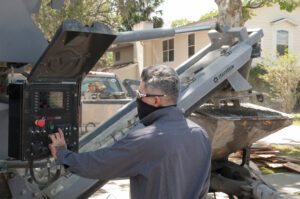
Tips For Pouring Concrete This Fall
As the leaves begin to change and the temperature starts to drop, it’s important for concrete
professionals to adjust their techniques and practices accordingly. Fall brings unique challenges
that can affect the outcome of concrete projects, from temperature fluctuations to moisture
levels. To ensure the best results, here are some essential tips for pouring concrete during the
autumn months.
1. Monitor the Weather Closely
Fall weather can be unpredictable, with temperature swings and the possibility of rain. It’s
crucial to keep a close eye on the weather forecast leading up to your concrete pour.
Temperature extremes can impact the curing process, while rain can compromise the quality of
the finished product. Plan your pour on days with stable temperatures and minimal rain
chances.
2. Adjust Mix Designs
As the temperature drops, the rate of concrete curing slows down. To counteract this, consider
adjusting your mix design by using accelerators. These additives can help speed up the
hydration process and allow the concrete to gain strength more quickly. Work closely with your
concrete supplier to determine the right accelerator and dosage for the ambient conditions.
3. Use Insulated Blankets
To combat the cooler temperatures that often accompany fall, utilize insulated blankets to cover
freshly poured concrete. These blankets help to maintain a consistent temperature and protect
the concrete from freezing during the critical curing period. Make sure the blankets are properly
secured to prevent wind from lifting them.
4. Plan for Early Finishing
With the sun setting earlier in the fall, daylight hours for finishing and curing are limited. Plan
your pour accordingly, aiming to complete the placement and initial finishing during the daytime
hours. This will allow for adequate curing time before temperatures drop further at night.
5. Watch Out for Leaves
Fallen leaves can be more than just an aesthetic issue. They can get blown onto freshly poured
concrete and create an uneven surface when they are removed. Additionally, decomposing
leaves can release acids that may negatively affect the concrete’s surface. Keep the work area
clean and use protective covers to prevent leaves from coming into contact with the concrete.
6. Properly Cure the Concrete
Curing is a critical step in the concrete process, and it becomes even more important in cooler
temperatures. Consider using curing compounds or cover the surface with wet burlap to
maintain moisture levels and promote proper strength development. Extended curing times
might be necessary due to the slower curing rate in the fall.
7. Plan for Freezing Conditions
If you’re working in an area where freezing temperatures are common during the fall, take
precautions to prevent freeze-thaw damage. Use air-entrained concrete, which contains
microscopic air bubbles that provide room for water to expand when it freezes. Additionally,
avoid de-icing chemicals on newly poured concrete surfaces.
8. Maintain Proper Drainage
With the potential for increased rainfall in the fall, ensure that your worksite has proper drainage
to prevent water from pooling around the freshly poured concrete. Improper drainage can lead
to surface defects and weakened concrete.
9. Communicate with Your Team
Effective communication is always crucial, but it becomes even more essential during
challenging weather conditions. Ensure that your team is well-informed about the specific
challenges posed by fall weather and the strategies you’ll be implementing to address them.
By following these tips and adapting your approach to the unique challenges of fall, you can
ensure successful concrete pours and deliver high-quality results for your clients. Remember
that each project may have its own specific requirements, so staying flexible and prepared is
key to mastering concrete work during this season.